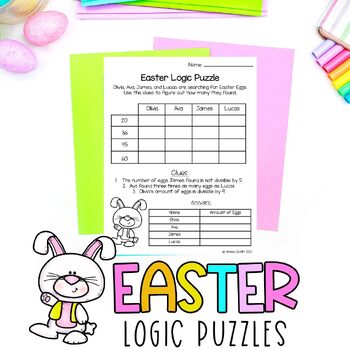Logic Puzzles Math Puzzle Activity | FREEBIE | Easter and Spring Theme
29,186 Downloads
Aimee's Edventures LLC
18.5k Followers
Grade Levels
3rd - 5th
Subjects
Resource Type
Standards
CCSS4.OA.A.1
CCSS4.OA.A.2
CCSS4.OA.A.3
CCSS4.OA.B.4
CCSSMP1
Formats Included
- PDF
Pages
4 pages
Aimee's Edventures LLC
18.5k Followers
Description
Two FREE Easter and Spring Math Logic Puzzles for students to practice critical thinking and basic math skills! Use as an Easter enrichment activity for early finishers, a cooperative learning activity, or a math center. No prep and print activity. Compatible with Google Slides, Kami, and Easel! Answer keys included.
What will this review?
This is the perfect resource to review for end-of-the-year benchmark testing in upper elementary.
- Factors and Multiples
- Prime and composite numbers
- Multiplication and Division facts
- Place Value
- Basic Problem Solving/Critical Thinking Skills
Total Pages
4 pages
Answer Key
Included
Teaching Duration
N/A
Report this resource to TPT
Reported resources will be reviewed by our team. Report this resource to let us know if this resource violates TPT’s content guidelines.
Standards
to see state-specific standards (only available in the US).
CCSS4.OA.A.1
Interpret a multiplication equation as a comparison, e.g., interpret 35 = 5 × 7 as a statement that 35 is 5 times as many as 7 and 7 times as many as 5. Represent verbal statements of multiplicative comparisons as multiplication equations.
CCSS4.OA.A.2
Multiply or divide to solve word problems involving multiplicative comparison, e.g., by using drawings and equations with a symbol for the unknown number to represent the problem, distinguishing multiplicative comparison from additive comparison.
CCSS4.OA.A.3
Solve multistep word problems posed with whole numbers and having whole-number answers using the four operations, including problems in which remainders must be interpreted. Represent these problems using equations with a letter standing for the unknown quantity. Assess the reasonableness of answers using mental computation and estimation strategies including rounding.
CCSS4.OA.B.4
Find all factor pairs for a whole number in the range 1-100. Recognize that a whole number is a multiple of each of its factors. Determine whether a given whole number in the range 1-100 is a multiple of a given one-digit number. Determine whether a given whole number in the range 1-100 is prime or composite.
CCSSMP1
Make sense of problems and persevere in solving them. Mathematically proficient students start by explaining to themselves the meaning of a problem and looking for entry points to its solution. They analyze givens, constraints, relationships, and goals. They make conjectures about the form and meaning of the solution and plan a solution pathway rather than simply jumping into a solution attempt. They consider analogous problems, and try special cases and simpler forms of the original problem in order to gain insight into its solution. They monitor and evaluate their progress and change course if necessary. Older students might, depending on the context of the problem, transform algebraic expressions or change the viewing window on their graphing calculator to get the information they need. Mathematically proficient students can explain correspondences between equations, verbal descriptions, tables, and graphs or draw diagrams of important features and relationships, graph data, and search for regularity or trends. Younger students might rely on using concrete objects or pictures to help conceptualize and solve a problem. Mathematically proficient students check their answers to problems using a different method, and they continually ask themselves, "Does this make sense?" They can understand the approaches of others to solving complex problems and identify correspondences between different approaches.




